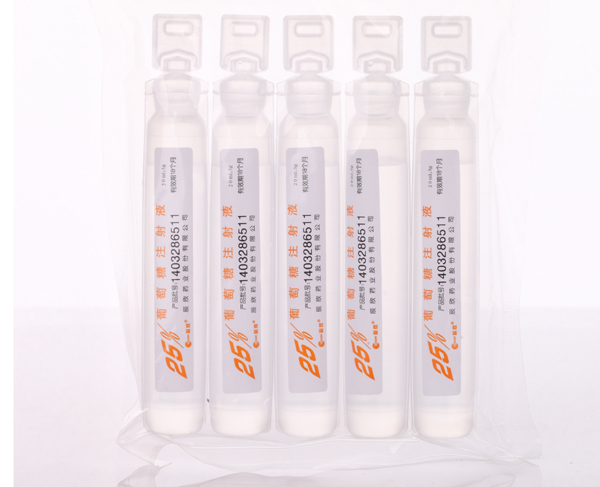Description: Glucose Injections are sterile, nonpyrogenic hypertonic solutions for fluid replenishment and caloric supply.
Polypropylene Ampoule are a groundbreaking new developments for replacing glass ampoules, with priceless advantages: Breaking is easy, no shreds, no sharp edges, no danger for scars or cuts of the skin.Plastic ampoule is not fragile, no need for special handling with care during shipment, storage or the final application.Filling up doesn’t need expensive and hazardous technology of flame welding. It is easy, cost and energy efficient on automatic process machines, with high precision of dosing.The tip of the Polypropylene Ampoule could be used for temporary re-closing.There are more auxiliary utilization like pre-inserted soft drop-by-drop dispensing system or the special patented membrane system for two-components applications.Wide range of decoration options are available, like silk screen printing, hot stamping and using of coloured material.The raw material is environment friendly and fully recyclable polypropylene.
Pharmacological effects: Glucose Injection have value as a source of water and calories. They are capable of inducing diuresis depending on the clinical condition of the patient.
Indications: Glucose Injection are indicated as a caloric component in a parenteral nutrition regimen. Following suitable admixture of prescribed drugs, the dosage is usually dependent upon age, weight and clinical condition of the patient as well as laboratory determinations. See directions accompanying drugs.Parenteral drug products should be inspected visually for particulate matter and discoloration prior to administration whenever solution and container permit.Do not administer unless solution is clear and seal is intact. Use of a final filter is recommended during administration of all parenteral solutions where possible. The dosage selection and constant infusion rate of intravenous dextrose must be selected with caution in pediatric patients, particularly neonates and low birth weight infants, because of the increased risk of hyperglycemia/ hypoglycemia. Frequent monitoring of serum glucose concentrations is required when dextrose is prescribed to pediatric patients, particularly neonates and low birth weight infants. The infusion rate and volume depends on the age, weight, clinical and metabolic conditions of the patient, concomitant therapy and should be determined by the consulting physician experienced in pediatric intravenous fluid therapy. 70% Glucose Injection, USP in the Pharmacy Bulk Package is intended for use in the preparation of sterile, intravenous admixtures. Additives may be incompatible with the fluid withdrawn from this container. Complete information is not available. Those additives known to be incompatible should not be used. Consult with pharmacist, if available. When compounding admixtures, use aseptic technique. Mix thoroughly. Do not store any unused portion of the 70% Glucose Injection.
Precautions: Administration of hypertonic dextrose and amino acid solutions via central venous catheter may be associated with complications which can be prevented or minimized by careful attention to all aspects of the procedure. This includes attention to solution preparation, administration and patient monitoring. It is essential that a carefully prepared protocol, based upon current medical practice, be followed, preferably by an experienced medical team. The package insert of the protein (nitrogen) source should be consulted for dosage and all precautionary information. Monitor changes in fluid balance, electrolyte concentration, and acid base balance during prolonged parenteral therapy or whenever the conditions of the patient warrants such evaluation. Care should be taken to avoid circulatory overload, particularly in patients with cardiac insufficiency. Caution must be exercised in the administration of these injections to patients receiving corticosteroids or corticotropin. These injections should be used with caution in patients with overt or subclinical diabetes mellitus. Drug product contains no more than 25 mcg/L of aluminum.
Adverse reaction: Too rapid infusion of a hypertonic dextrose solution may result in diuresis, hyperglycemia, glycosuria, and hyperosmolar coma. Continual clinical monitoring of the patient is necessary in order to identify and initiate measures for these clinical conditions. Hypersensitivity reactions, including anaphylaxis and chills. Reactions which may occur because of the solution or the technique of administration include febrile response, infection at the site of injection, venous thrombosis or phlebitis extending from the site of injection, extravasation and hypervolemia. If an adverse reaction does occur discontinue the infusion, evaluate the patient, institute appropriate therapeutic countermeasures, and save the remainder of the fluid for examination if deemed necessary.

